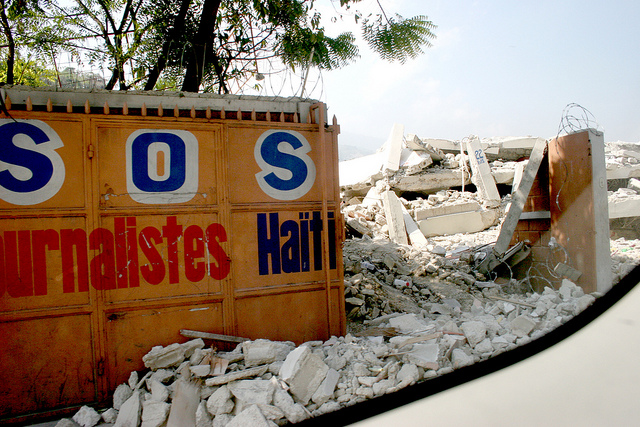
On Tuesday, January 12, 2010, an earthquake, one of the deadliest in history, struck Haiti and killed over 300,000 people. In the aftermath, governments and aid organizations rushed in to help, saving thousands of lives but also giving rise to longer-term problems. In advance of the Zócalo event “Does Hollywood Really Help Haiti?” we asked several people with extensive knowledge of nonprofits, NGOs, and Haiti to offer their thoughts on the following, related question: Has the United States primarily helped or hurt Haiti since the earthquake of 2010?

In the 34 months since the earthquake, governments and multilateral organizations have disbursed almost $6 billion in aid to help the people of Haiti, the equivalent of $600 per person for a country where per capita annual income is just $670.
Where has all the money gone?
Our policy paper with the Center for Global Development tackles this question. The short answer is that the vast majority of funds disbursed so far have been paid to international NGOs and private contractors. By our estimates, 10 private contractors have received over $437 million. Over 75 percent of all funds disbursed by the United States Agency for International Development (USAID) went to firms inside the D.C.-Maryland-Virginia beltway, leading some to call this process a “gold rush.” While many of these private contractors and NGOs do great work, there is shockingly little information on how they use the funds. These entities have limited accountability and undergo few evaluations of services delivered, lives saved, or mistakes made.
It is also difficult to know whether Haitians have been involved in the relief effort. NGOs and private contractors in Haiti have built an extensive infrastructure for the provision of social services. The Haitian government historically has had limited capacity and weak national institutions. Earthquake relief further exacerbated this problem by bypassing Haitian institutions and civil society. Our analysis shows that less than one percent of aid went to the government of Haiti to rebuild public institutions. Contracts to Haitian firms were also less than one percent of total contracts awarded by USAID. The money that has been spent was done so largely without consultation of locals. Only a handful of all the Haitians we interviewed have ever been contacted by members of the foreign assistance community to discuss local needs.
The bottom line is that 34 months after the quake, we do not really know where the money has gone. The lack of accountability of NGO expenditure in Haiti is unacceptable. Better monitoring, evaluation, and reporting by international NGOs and by the United States government is crucial. Haitians need to be included in the recovery process if the country is to make sustainable progress in the future.
Vijaya Ramachandran is a senior fellow and Julie Walz is a policy analyst at the Center for Global Development. They are the authors of a CGD policy paper “Haiti: Where Has All the Money Gone?” and a forthcoming book on the subject.

We are quickly approaching the third anniversary of Haiti’s devastating earthquake, that terrible day when over 200,000 Haitians lost their lives, thousands of businesses and homes were destroyed, and hundreds of thousands were displaced.
The international response was amazing. The country was flooded with first responders, medical teams, and volunteers, most of them from the United States. The United States was a huge help to Haiti in the first days and weeks when emergency medical assistance, food, potable water, and temporary shelters were so badly needed.
When it comes to immediate emergency relief, North America is most generous and can mobilize humanitarian efforts with the utmost efficiency.
The problem is that to continue to provide emergency help undermines the next step, sustainable development. Individual Americans, international NGOs, and religious groups have to be careful not to do the work that Haitians should be doing. I know of an American medical team that decided to build a clinic in southern Haiti. The Ministry of Health was never contacted. The Bureau of Planification (which tries to manage non-profits) was not consulted. Land was purchased and building began. When I spoke to the departmental director of public health, he had difficulty containing his resentment. Why wasn’t he in the loop? He had, after all, responsibly for all medical facilities and knew where clinics were most needed. Multiply this by the thousands as schools, orphanages, and medical facilities have popped up all over Haiti paid for by kind and well-meaning people from the U.S. If Haiti weren’t so poor and its infrastructure so weak, the aforementioned would be shut down.
Americans, as individuals, are the most generous people. I’m always impressed by the amount of charity shows on cable in the U.S. when I visit. Donate to help the animals or to help with disease research or to sponsor a child. I assume that donations are rolling in, since the shows continue year after year. What is needed after the initial relief effort, though, is a more thoughtful response. Haiti is not the East Coast of the U.S., which, while devastated at the moment from Hurricane Sandy’s vicious attack, will rebound. Haiti has deep-rooted problems that cannot be ignored, and to really help the Haitians in the long run, Haitians must be involved in the process of development, especially in the decision-making of sustainable programs.
Those of us committed to helping Haiti see three types of people and organizations here: missionaries, mercenaries, and misfits. Missionaries (not the traditional type) are here to accompany the Haitians and work with them to discover long-term solutions. Mercenaries are here to primarily satisfy their own needs. Misfits puzzle us and rarely have a positive impact. This is simplistic, of course, but broadly accurate. In my mind, a key opportunity lies with diaspora Haitians, who have achieved success abroad. They can share their diverse experience, education, and resources with those who continue to struggle in their homeland.
To summarize, American intervention immediately after the earthquake was terrific. We are not so good at the developmental, sustainable effort required to make a lasting contribution.
Fr. Marc Boisvert, OMI, is the founder and CEO of Pwoje Espwa Sud (PES), which provides for the needs of orphaned and vulnerable children in southern Haiti (www.freethekids.org).

In the aftermath of the January 12 earthquake, the world pledged around $5.3 billion to help rebuild Haiti. Whether by private donations through organizations like the American Red Cross, or through governmental bodies like USAID, the U.S. has been the single largest donor nation. While much of this aid has undoubtedly helped Haiti—particularly in the immediate aftermath of the tremblor—the longer-term picture is more complicated.
Emergency and development aid is difficult work, but aid organizations have often not made the process easy for themselves or the communities they hope to help.
Organizations frequently lack coordination, and many remain unregistered with the Haitian government, making reconstruction planning even harder.
Even before the earthquake, Haiti was in poor condition, but donors have appeared uninterested in building the capacity of the state—less than one percent of funds have been spent through the Haitian government. The U.S. has put more energy into post-earthquake projects like the Caracol Industrial Park, with its low-wage export sector jobs, than re-housing the hundreds of thousands who still remain in tent camps or revitalizing a moribund agricultural sector that employs around 60 percent of the population. Attention to the latter would be particularly welcome, given how American free trade policies in the 1990s helped devastate the rice sector through subsidized imports—an outcome that President Clinton himself recently found cause to apologize for. The fragile state of Haitian agriculture has left the country even more exposed to weather events like Tropical Storm Isaac and Hurricane Sandy, which have wreaked around $175 million of losses on Haitian farmers, greatly adding to fears of food insecurity.
People need to be reassured that the help they’re offering is having the intended effect. On this score, post-earthquake aid to Haiti has a distinctly mixed record.
Paul Clammer is a travel writer who divides his time between the U.K., Haiti and Morocco. He is the author of the Bradt Travel Guide’s Haiti, published in November 2012.

Let me answer from four different perspectives, each of which offers some truth:
First, the perspective of someone impressed by individual Americans’ generosity: I’ve spent time with many Haitians who are incredibly grateful for post-earthquake help they received. More could have been done. But the kindness of so many was inspiring, especially in the earliest days but also continuing now.
Second, the perspective of a veteran American NGO worker: Incrementalist. Mix of cynicism and hope. Do what you can. Stay positive. Not surprised by the help or hurt that has happened.
Third, the perspective of a righteously angry American: The 800-pound gorilla to Haiti’s north (the government, NGOs, corporations, missionaries, and volun-tourists of my home country) has done too much damage since Haiti’s independence in 1804 to be excused by good deeds since 2010. (Which weren’t done well enough, anyways.)
Fourth, of someone who after 10 years working in Haiti still feels that in a single community, let alone the whole country, it is important not to over-claim how much one understands: Pay attention and learn from the big-picture studies and critiques; focus energy where partnering together is bringing concrete, encouraging progress.
“Helped much more than hurt, I think,” said my Haitian colleague Enel when I called to ask him this question last night. He laughed at the question’s self-critical nature, since he has appreciated the post-earthquake help for his country. As I’ve written elsewhere, Enel was on the third floor of a university building that collapsed and got back to work as soon as he was able. His determination to keep improving his nation is one of the compelling personal reasons I do my work.
Helped more than hurt since January 12, 2010. That sounds right to me too. But as Enel and I both know and say often, the story is never simple.
Kent Annan is the author After Shock and Following Jesus Through the Eye of the Needle. He is also co-director of Haiti Partners. You can follow him on Twitter here.

On the surface, the answer is simple: it has helped. After the earthquake the U.S. government, along with U.S. organizations and individuals, played critical roles in delivering emergency healthcare and aid to Haitians. There were problems and failings with the way this aid was delivered. The response was more militarized than it needed to be, and relief agencies could have worked much more effectively with existing social and economic networks in distributing food. But lives were saved and conditions improved as the result of work done on behalf of U.S. troops and citizens. One lasting example of this is the new teaching hospital built by Partners in Health in Haiti.
But the answer gets more complicated when we move beyond the period immediately after the disaster to the longer period of reconstruction, during which the U.S. continued to play a determining role. And the role was a continuation of the long history of U.S. involvement. In a way, the question we need to pose is an admittedly broad one: “Has America primarily helped or hurt Haiti over the course of the 20th century?”
That question is a huge one—I try and give some answers in a recent book called Haiti: The Aftershocks of History—but it does ultimately point to one failing in the post-earthquake response: it wasn’t as inventive or imaginative as it should have been. Nearing three years after the disaster, the solutions offered—such as the large industrial park built with reconstruction money in the north of Haiti—were based too closely on older, and frankly tired, templates. Critical issues—particularly the revival of rural agriculture and a systematic approach to the question of construction and planning in Port-au-Prince—did not get the attention they should have.
The earthquake should have been taken as a call to action, indeed a call to arms, to invent new visions of the future. It was an opportunity to find ways of collaborating and working with Haitian communities and foregrounding their own political and economic visions and aspirations. Unfortunately that did not happen as much as it should have. The ultimate problem with the aid that was offered in the wake of the earthquake was that, ultimately, it didn’t break sufficiently with what had come before.
Laurent Dubois is a professor at Duke University, and author of Haiti: The Aftershocks of History.



